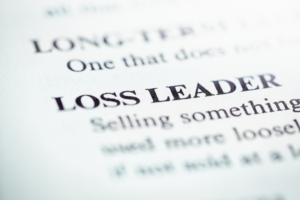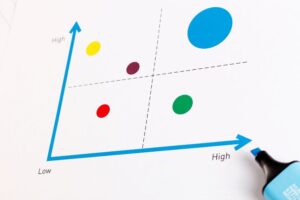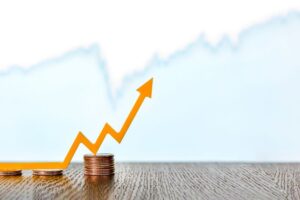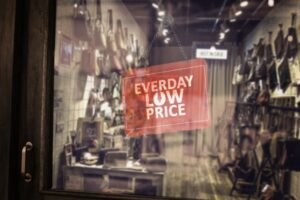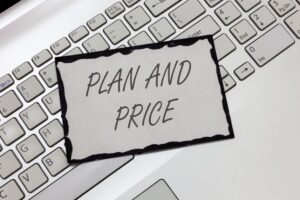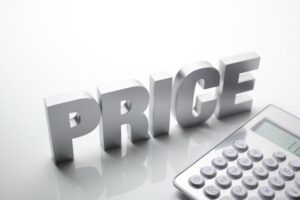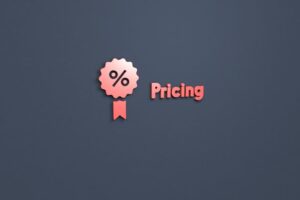Economy Pricing Strategy Definition
Economy pricing, also known as volume-based pricing, is a strategy where businesses price goods and services at a lower cost to appeal to price-sensitive customers. The goal is to maximize sales volume by offering the lowest price in the market.
With economy pricing, companies can reach a larger customer base, especially those on a tight budget. It allows more people to afford your products or services. However, profit margins are often lower, so you need to sell higher volumes to remain profitable

How Does Economy Pricing Work?
Economic pricing is based on a simple formula:
Production Cost + Desired Profit Margin = Sale Price
From this expression, you’ll realize that to keep your sale price low enough:
- You must reduce the costs of production and operations. The lower your costs, the lower you can set your prices.
- Competitors’ prices must be high enough that you can undercut them and still make a profit.
- There must be a large enough market of customers who are willing to switch brands or stores based primarily on price.
- Your desired profit margin has to be small but complemented with higher sales volumes to generate adequate profits.
In subsequent sections, we’ll explore different ways to keep your costs low and how to target a reasonable profit margin.
MORE: Membership vs subscription model
Advantages and Disadvantages of Economy Pricing
Economy pricing can be beneficial or harmful to businesses in several ways. These include:
| Pros | Cons |
|---|---|
| Economy pricing allows companies to penetrate competitive markets. | Competitors may respond to economy pricing by lowering their prices. |
| Lower prices often result in higher sales volumes. | Lower prices mean reduced profit margins. |
| It’s an effective way to attract and acquire new customers. | Customers who are attracted to a company’s low prices may be quick to switch to competitors if they offer even lower prices. |
| Lower prices can help businesses attract price-sensitive customers who may become loyal to the brand. | Some customers may associate low prices with low quality. |
MORE: What is bundle pricing?
Economy Pricing Examples
Some well-known brands employ economy pricing to reach more customers. Here are a few examples:
1. Walmart
Walmart has long been known for its “Every Day Low Price” (EDLP) guarantee. This philosophy is not just a pricing strategy; it’s the very essence of their identity. Walmart has managed to keep product prices low by leveraging its massive scale and efficient supply chain management to negotiate lower prices from suppliers.
2. McDonald’s
McDonald’s fast food restaurants offer affordable meal options. With their popular Saver Menu or $1 $2 $3 Dollar Menu, you can indulge in various delectable treats without breaking the bank. McDonald’s also offers value-for-money meal bundles, such as the McFamily bundle or the McValue bundle.
3. Spirit Airlines
The skies are no longer reserved for the rich. Spirit Airlines has made air travel more accessible to the masses by offering low-cost flights with minimal frills. They manage to lower their costs by stripping down the extras like pre-reserved seats, free snacks and drinks, and carry-on bags. Customers have the option to pay more for add-ons if desired, but the cheap ticket price attracts many budget travelers.
4. Generic or Store Brand Products
Grocery stores and retailers often have their own generic or private-label brands that are priced lower than big-name brands. Products like over-the-counter medications, canned goods, paper products, and more are produced at a lower cost and sold at a lower retail price.
MORE: What is penetration pricing?
When to Use Economy Pricing
Economy pricing can be an effective strategy for your business in several situations:
1. When Entering a New Market
If you’re launching a new product or service, economy pricing can help you gain market share quickly. Setting a low initial price will attract more customers and spread word-of-mouth publicity. You can then raise prices gradually as your product gains more traction.
2. In Highly Competitive Markets
When many competitors are selling similar products, economy pricing gives you a competitive advantage. Your lower prices will win over budget-conscious customers, allowing you to gain a foothold in the market.
MORE: What is competitive pricing?
3. During an Economic Recession
When consumers are more price-sensitive due to economic conditions, economy pricing makes your offerings more accessible and appealing. While your profit margins may decrease, you can still generate sales and revenue to weather the downturn.
4. When Your Business Generates High Sales Volumes
If you sell a high quantity of products, you can offset lower markups through increased sales. The larger volume of customers will still translate to solid revenue and profits overall. This works best for businesses with low variable costs that can keep total costs in check.
5. When Dealing with Price-sensitive Customers
Economy pricing is essential for products targeting very budget-conscious customer segments. This group usually includes students, retirees, people with limited income, and customers who are simply looking for the best deals and discounts. These customers are motivated primarily by price, so lower prices are the main driver of their purchasing decisions.
MORE: What is usage based pricing?
Businesses and Products Best Suited to an Economy Pricing Strategy
Certain types of companies and products are ideally suited to an economy pricing strategy. Some examples include:
- Generic Grocery Items
Store brands and generic products can be priced lower since there is little differentiation. Think of your everyday staples like milk, eggs, bread, rice, and canned goods. These products are often sold at lower prices than their branded counterparts.
- Cosmetics Retailers
Stores that sell lower-cost makeup, skincare, and hair products at a discount can gain market share with an economy pricing strategy. They keep costs low by having a limited selection and private labeling products.
- Fast-food Chains
Fast food restaurants offer cheap meals by simplifying their menu, using inexpensive ingredients, and employing cost-efficient cooking methods. They can pass the savings to customers through economy meal deals and value menus.
- Budget Airlines
By eliminating amenities like meals, roomy seats, and legroom, budget airlines can slash fares and open up air travel to more people through economy pricing. They maximize the number of seats on each flight to keep costs per customer low.
- Discount Retailers
Stores like dollar stores, outlet malls, clearance centers, and budget superstores are all about economy pricing. They offer a broad range of goods at the lowest possible prices by buying surplus inventory, store overstock, and out-of-season products to resell to price-conscious customers.
MORE: What is market-based pricing?
How to Implement Economy Pricing in Your Business
To implement an economy pricing strategy in your business, here are key steps to follow:
- Access your business model,
- Analyze your competition,
- Optimize production costs,
- Set your prices,
- Review and adjust.
Assess Your Business Model
Understanding your business model is crucial when considering economy pricing. This is because economy pricing may require significant changes in your operations, marketing, and even in the product or service itself. You need to ensure that your business can still be profitable despite the low prices.
Your target market and products must also align with the strategy. Economy pricing is primarily attractive to cost-sensitive buyers. If your customers prefer lower prices, then this strategy has a good chance of working out; otherwise, they’ll think your products are inferior because they are cheap.
Analyze Your Competition
If you’re planning to lower your prices, you need to ensure that you still maintain a competitive edge. Understanding your competitors’ pricing strategies helps identify areas where you can outperform them.
Moreover, If your competitors are already using economy pricing, it could be an indication that your target market is highly price-sensitive. If they’re not, it could either signal an opportunity or a warning that this strategy may not work in your market.
Start by identifying who your direct competitors are. A simple Google search using relevant keywords can reveal similar businesses in your industry. You can also use SimilarWeb to find more competitors. Visit their websites, and check their offers and pricing. You don’t need to match them exactly, but they can provide a benchmark
Optimize Production Costs
If production costs are too high, economy pricing might make your business unsustainable over the long term. So, you must find out if there are any areas of your business where you can cut costs. While cutting costs is necessary, you must do it effectively without compromising the quality of your product or service.
Start by understanding what drives your costs. This could be materials, labor, equipment, or overheads. For materials, you may consider reducing packaging or buying materials in large volumes. If you want to save on labor costs, consider outsourcing non-core activities if it’s cheaper or automating certain processes.
Set Your Prices
Now, with lesser costs and insights into your competitors’ prices, it’s time to set yours. What is the minimum profit margin you need to maintain to remain financially sustainable? After adding the profit margin to your costs, will it be similar to or slightly less than your competitor’s price?
Even with lower prices, it’s important to communicate the value of your products or services. This can help avoid the perception that low price equals low quality.
Review and Adjust
Once you’ve set your prices, monitor your sales and profitability closely. Look at traffic, conversion rates, sales volume, and customer feedback. CRM software like Freshsales or Pipedrive offers comprehensive reporting and analytics to help you understand the performance of your pricing strategy.
Also, review your costs to ensure that your current pricing strategy is still profitable. If your costs have increased, you may need to up your prices as well. At the same time, look for opportunities to cut costs further and reduce prices to stay competitive.
MORE: What is value-based pricing?
Key Takeaways
When done right, economy pricing can be an effective strategy for gaining market share and improving cash flow. The combination of lower prices and higher turnover opens doors to new customers and bigger profits. But businesses must always keep costs in check and volume high, or the model won’t work.
Visit SaaSGenius to learn more about software solutions, hacks, and business advice that will help you not only properly implement your pricing strategy but also boost your business performance.
Related Posts
Frequently Asked Questions (FAQ)
Author
Methodology
- Who?
We are SaaS experts: Our specialists constantly seek the most relevant information to help support your SaaS business. - Why?
We are passionate about users accessing fair SaaS pricing: We offer up-to-date pricing data, reviews, new tools, blogs and research to help you make informed SaaS pricing decisions. - How?
With accurate information: Our website manager tests each software to add a Genius Score using our rating methodology to each product. Our editorial team fact-check every piece of content we publish, and we use first-hand testing, value metrics and leading market data.
